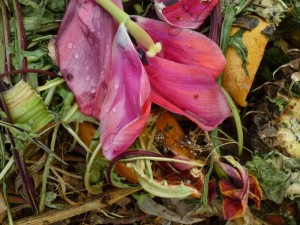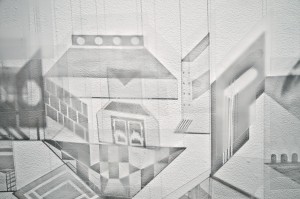
Steve Fitch, Screen Towers, 1980 to 1995, 2012
With Contemporary Eye, Merry Scully Curates New Mexico Museum of Art Alcove Shows
Merry Scully is the curator of special projects at the New Mexico Museum of Art. This year she is working on a series of small one-person shows in the alcove spaces of the New Mexico Museum of Art. The Alcove 12.1-9 exhibitions will showcase 45 artists from New Mexico, each for five weeks at a time. The spaces vary in size from 6.5’ deep and 14’ wide to 11′ deep by almost 19’ wide.
Was there a specific mission from the museum for the Alcove series? How did the idea come about?

Left, Martha Etsitty, Eyedazzler, circa 1976
Right, Will Wilson, Pamela Brown, Joy Farley, Jaime Smith and Dylan McLaughlin, eyeDazzler, 2011
The Alcove shows are a tradition at the Museum of Art that in some ways date back to our beginnings. The museum was founded [in 1917] to show work being made at that time and the museum was a place where artists gathered. Many of the artworks and artists who exhibited in those early years now form the historic core of our permanent collection. The Centennial of the state and the upcoming 100th anniversary of the museum started the conversation about bringing back the Alcoves.
We wanted to put together a series of exhibitions focused on artists working in New Mexico now and to create around that a culture of exchange and conversation. That’s why we have informal gallery talks – where we walk through the exhibit and encourage dialogue. It’s also why we host a breakfast reception on Saturday mornings with a small group of alcove alum and guests primarily invited by the artists.
This is a big project for you. What were the first things you did to organize it?
The first thing I did was think about artists whose work I had seen, especially people outside of Santa Fe, who I thought had a serious artistic practice, who made interesting work and who I had been wanting to exhibit. I guess the actual first thing I did was go through the calendar and try and figure out a rotation schedule that would be equitable.
Were there themes that emerged from your groupings that were either intentional or unintentional?

Nancy Sutor, COMPOSE DECOMPOSE: Compost, Pink Tulip, 2011
When I first began working on the series I began to think of each grouping focused around a theme – quickly I realized that this was actually not the best approach. For instance, the first group of artists I was working with and considering had a relationship to mapping – but as I began working I realized that using “mapping” as a theme actually diluted some of the more interesting associations that a couple of the artists were working with. I then realized that these were to be five small one-person exhibitions that ran side by side. Five jewel boxes that either gave a broad sense of the artist’s practice or an aspect of their larger body of work.
The scale of each alcove impacts the work a great deal. When you and the artists discussed their show, what kind of conversation did you have regarding scale and relationship to space, not only their own alcove but also the neighboring ones?
At first I had to explain to artists what the alcoves were – the last time an alcove rotation happened was the mid-1990s. Many thought it would be one or two pieces. Since it’s New Mexico I would tell them it’s an “alcove” show not a “nicho” show.

Ted Larsen, Rodeo Clown, 2012
The spaces are not large but there is enough space to get a sense of what the artists are working on – often we would edit to fit the space – or end up settling on different work than I had originally came to see as the space and the relationship to the other artists work is important to me. I don’t really discuss much who the other artists are or what their work will be with the others in the exhibit. Not to keep it secret, but because the shows are evolving as they are going up – and often I am in simultaneous conversation with all five artists at the same time. Unlike most museum exhibits these alcove shows are evolving up to the minute they are installed.
You already knew many artists in New Mexico as curator for the Governor’s gallery, but your network must have expanded for this project. It would be interesting to hear if you have a different idea of art being made in the state, if there were any surprises for you, if you have a sense of the seriousness of the artists who live here.

Scuba, The World is Flat (detail), 2012
The first few years I was working for the Governor’s Gallery the Richardsons and the Museum of Art placed a premium on getting around the state – so I did. I drew pretty heavily on those years for the artists who are outside of Santa Fe. The schedule for getting these up and down in addition to my other responsibilities has really tied me to my office – which is too bad.
I wasn’t surprised at the seriousness of artists who live here – and I think I can safely say that in no other state the size of NM could we have embarked with confidence on a project like this, with as quick a turnaround from idea to installation, and know we could find so many artists ready with a cohesive body of work ready to install. As a state we have a critical mass of serious artists – of course NY and California and Texas have loads of great artists – but we are a very small population state, and a very poor state. We are rich in art – the visual arts being just one aspect.
Maybe the convivial format of the alcoves is to re-iterate the state’s historic welcoming of artists.
That is a really nice way to think about this series! How did you get involved in curation, what is your background?

Terri Roland, Insect Time, 2012
I was really fortunate to have a best friend whose parents were really interested in art – they piqued my interest from a young age and made art feel vital, alive and accessible. I spent days and days at the museum (LACMA) – and at the Junior Art Center in Barnsdale Park. I began as a maker. I started putting together exhibitions soon after I finished my undergrad degree in LA, and after earning my MFA at UNM went back to LA, worked on both public and private collections and exhibitions, then got a position at the San Francisco Art Institute, working on exhibitions and programming. That’s when I stopped making my own work and focused on working with others. We produced many new commissions. I think having been an artist/ maker really helps me as a curator. I love art history but there is something about making and having made things that often helps me facilitate projects with artists.
I love that I get to engage with art and artists on a regular basis. The Alcoves have been a great treat for me.
And maybe have given you a few gray hairs.
That is what hair dye is for.
